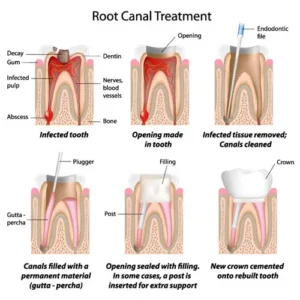You may be surprised when your dentist refers you to a periodontist (gum specialist) before you receive veneers, crowns, bridges or another type of restorative treatment. The reason is simple: general dentists need healthy gum tissue and a sound tooth structure before a tooth can be restored.
Surgical crown lengthening is a procedure that re-contours the gum tissue and/or bone to allow a tooth to be restored. You may need this if you have fractured a tooth, developed cavities under the gum tissue, have deep fillings under the gum tissue, or have teeth that are worn down and very short. In these cases, your dentist may need more tooth to help cement the crown and help seal the tooth to the crown so bacteria cannot leak under the crown.
A general dentist also needs to have the crown margin (where your tooth meets the crown) at or just below the gum line. If the crown margin invades under the gum line, the junction between the crown and tooth will allow bacteria to accumulate and you may suffer from inflammation that leaves the gum red, swollen and painful. This infection can be difficult to treat; a routine cleaning will not make the problem go away and you probably may need a deep cleaning, local antibiotics, laser therapy or surgery to resolve the problem. The general dentist will have the periodontist reset the gum tissue toward the root of the tooth, which will create a space to allow for proper hygiene to keep the gum tissue healthy and pink.
What to Expect
The crown lengthening procedure is a simple treatment done under local anesthesia. After the area is numb, the gum is released from the tooth and the tissues remodeled to create more tooth structure for the general dentist to use to allow a better seal and to move the margin of the crown away from the bone. Usually the periodontist will place two sutures that come out on their own. The periodontist will schedule you for two post-operative visits to confirm your mouth has healed and is ready for the restorative treatment. It may take as little as eight weeks to heal for a simple case or as long as six months for complex cases involving multiple teeth.
Seeing is Believing
Below is an example of a crown lengthening performed on a top left tooth that originally had poor crown margins and the gum tissue was red, swollen and unhealthy. The crown lengthening restored the tooth to the same size as the natural tooth, removed the puffy red tissue and gave the dentist enough tooth to give the patient a great, cosmetic crown.
Here is an example of a patient who needed crowns to be placed on several top left teeth that were short and had large fillings. Crown lengthening surgery made the teeth appear longer and the dentist could adequately prepare the teeth for the crowns. The bigger teeth allowed the crowns to hold onto more tooth structure and created a longer seal, which decreases bacterial leakage.
Michael Quinn, DMD, MHS , has been a practicing dentist since 1987. He is a Board Certified Periodontist and provides periodontal services to patients starting at age 8. Special services include all periodontal services, bone grafting, crown lengthening, dental implants and restorations, endodontic surgery, extractions, gummy smile treatment, laser treatment, periodontal disease management, pre-prosthetic surgery, ridge augmentation, soft tissue grafts and sinus lift. He practices at several Coast Dental offices in Georgia including ones in Atlanta, Marietta, Fayetteville, Lawrenceville, and Stone Mountain.
, has been a practicing dentist since 1987. He is a Board Certified Periodontist and provides periodontal services to patients starting at age 8. Special services include all periodontal services, bone grafting, crown lengthening, dental implants and restorations, endodontic surgery, extractions, gummy smile treatment, laser treatment, periodontal disease management, pre-prosthetic surgery, ridge augmentation, soft tissue grafts and sinus lift. He practices at several Coast Dental offices in Georgia including ones in Atlanta, Marietta, Fayetteville, Lawrenceville, and Stone Mountain.
Written by: Michael Quinn, DMD, MHS and Beth Gaddis
Reviewed by: Cindy Roark, DMD
Related Posts

What is a Root Canal and Crown?
Root canal therapy is used to repair and save a tooth that has been damaged either from an injury or

What Is Bone Grafting?
A great smile requires more than just healthy teeth. It also requires healthy gums and a healthy jaw bone. The

Type of Dental Crowns and Cost
If you’re like most people, you’ll probably need a crown at some point. A crown is a type of dental restoration that covers

